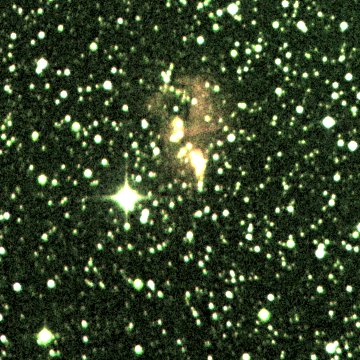Sh 2-127
Coordinates: (96.29°, 2.6°)
[ Catalog | Explorer | SIMBAD ]
According to a 1978 study, Sh 2-120, Sh 2-121, Sh 2-127 and Sh 2-128 are all at about the same distance of 7500 parsecs and are "probably distant HII regions associated with a spiral feature more distant than the Perseus arm".
Radio analysis reveals that Sh 2-127 consists of two distinct components - a larger weaker and more diffuse source (WB89 85A) to the northeast, consistent with ionisation by an O7 class star, and a stronger but smaller source to the southwest (WB89 85B), consistent with ionisation by an O8.5 class star. (However, it is also possible that both components are ionised by a single star.) Both components are located near the northwestern edge of a molecular cloud and are embedded in the molecular gas.[2]
SIMBAD associates Sh 2-127 with the radio source KR 17, but this paper identifies KR 17 with Sh 2-187 in a completely different region of sky.[3]
Notes
1. ^ Crampton, D., Georgelin, Y. M., & Georgelin, Y. P. (1978). "First optical detection of W51 and observations of new H II regions and exciting stars", Astronomy and Astrophysics, Vol. 66, 1-11. [1978A&A....66....1C]
2. ^ Rudolph, Alexander L., Brand, Jan, de Geus, Eugene J., et al. (1996). "Far Outer Galaxy H II Regions", The Astrophysical Journal, Vol. 458, 653. [1996ApJ...458..653R]
3. ^ Kerton, C. R. (2006). "A sharper view of the outer Galaxy at 1420 and 408 MHz from the Canadian Galactic Plane Survey - I. Revisiting the KR catalogue and new Gigahertz Peaked Spectrum sources", Monthly Notices of the Royal Astronomical Society, Vol. 373, 1203-1212. [2006MNRAS.373.1203K]
Links
[ DSS | ADS | ADS Abstract ]
map | book | blog | gallery | sources

This image was created using the POSS-II/UKSTU data of the Digitized Sky Survey and SuperCOSMOS using the process described here.
According to my correspondence with the Royal Observatory Edinburgh and the Space Telescope Science Institute, I am allowed to use the POSS-II/UKSTU data to create and display images for non-commercial purposes so long as I include this fine print for the SuperCOSMOS data:
Use of these images is courtesy of the UK Schmidt Telescope (copyright in which is owned by the Particle Physics and Astronomy Research Council of the UK and the Anglo-Australian Telescope Board) and the Southern Sky Survey as created by the SuperCOSMOS measuring machine and are reproduced here with permission from the Royal Observatory Edinburgh.
and this acknowledgement taken from the DSS site:
The Digitized Sky Surveys were produced at the Space Telescope Science Institute under U.S. Government grant NAG W-2166. The images of these surveys are based on photographic data obtained using the Oschin Schmidt Telescope on Palomar Mountain and the UK Schmidt Telescope. The plates were processed into the present compressed digital form with the permission of these institutions.
The Second Palomar Observatory Sky Survey (POSS-II) was made by the California Institute of Technology with funds from the National Science Foundation, the National Geographic Society, the Sloan Foundation, the Samuel Oschin Foundation, and the Eastman Kodak Corporation.
The UK Schmidt Telescope was operated by the Royal Observatory Edinburgh, with funding from the UK Science and Engineering Research Council (later the UK Particle Physics and Astronomy Research Council), until 1988 June, and thereafter by the Anglo-Australian Observatory. The blue plates of the southern Sky Atlas and its Equatorial Extension (together known as the SERC-J), as well as the Equatorial Red (ER), and the Second Epoch [red] Survey (SES) were all taken with the UK Schmidt.
The "Second Epoch Survey" of the southern sky was made by the Anglo-Australian Observatory (AAO) with the UK Schmidt Telescope. Plates from this survey have been digitized and compressed by the ST ScI. The digitized images are copyright ? 1993-5 by the Anglo-Australian Observatory Board, and are distributed herein by agreement.
The "Equatorial Red Atlas" of the southern sky was made with the UK Schmidt Telescope. Plates from this survey have been digitized and compressed by the ST ScI. The digitized images are copyright ? 1992-5, jointly by the UK SERC/PPARC (Particle Physics and Astronomy Research Council, formerly Science and Engineering Research Council) and the Anglo-Australian Telescope Board, and are distributed herein by agreement.
The compressed files of the "Palomar Observatory - Space Telescope Science Institute Digital Sky Survey" of the northern sky, based on scans of the Second Palomar Sky Survey are copyright ? 1993-1995 by the California Institute of Technology and are distributed herein by agreement. The compressed files of the "Palomar Observatory - Space Telescope Science Institute Digital Sky Survey" of the northern sky, based on scans of the Second Palomar Sky Survey are copyright ? 1993-1995 by the California Institute of Technology and are distributed herein by agreement.